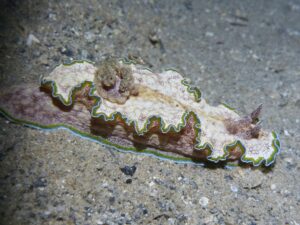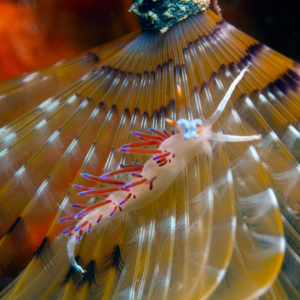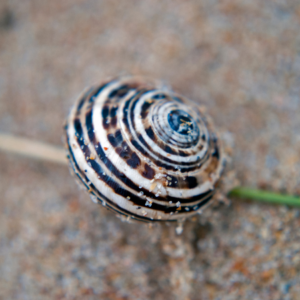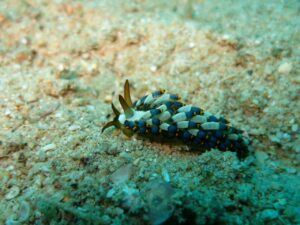Sea Snails
1.Introduction to Sea Snails
a. Brief Overview
Sea snails, a quintessential part of the marine world, belong to the class Gastropoda, which includes both land and sea species. These marine mollusks are admired for their diverse shapes, sizes, and colorful shells, making them a fascinating study for marine biologists and enthusiasts alike. They occupy various niches in the ocean, from the intertidal zone to the abyssal depths, showcasing an impressive adaptability to different environmental conditions. Their slow-paced, tranquil existence belies the crucial roles they play in their habitats, contributing to the marine biodiversity that sustains ocean health.
b. Importance in Ecosystems
In natural ecosystems, sea snails are indispensable. They act as grazers, feeding on algae, which helps prevent excessive algal blooms that can be detrimental to marine environments. Their presence contributes to nutrient cycling, breaking down detritus and facilitating the redistribution of nutrients throughout the ocean floor. Moreover, sea snails serve as prey for a variety of marine species, including fish, birds, and mammals, thus occupying a vital link in the marine food web. By maintaining the balance of marine ecosystems, sea snails ensure the health and sustainability of their environments.
c. Importance in Aquariums
In aquariums, sea snails are not just decorative; they play a critical role in the maintenance of the aquatic ecosystem. They are natural cleaners, diligently working to remove algae, detritus, and uneaten food from the tank, contributing to cleaner, healthier water conditions. Their activities help to stabilize the aquarium’s ecosystem, reducing the need for chemical cleaners and promoting a more natural environment for fish and other marine invertebrates. For aquarium hobbyists, sea snails are invaluable allies in creating a balanced, dynamic, and visually appealing underwater world.
2.Understanding Sea Snails

a. Characteristics of Sea Snails
Sea snails, a fascinating group of marine gastropods, are known for their diverse and often intricate shells. These shells, which can vary widely in shape, size, and color, serve as a protective barrier against predators and environmental hazards. Sea snails possess a unique organ called a radula, a ribbon-like structure with thousands of microscopic teeth used for feeding. They move via a muscular foot, which also aids in burrowing into the substrate for some species. Adapted to a variety of marine environments, sea snails exhibit a range of feeding behaviors, from herbivorous grazers to carnivorous hunters, showcasing their adaptability and diversity.
b. Habitat and Distribution
Sea snails are ubiquitous across the world’s oceans, occupying a wide array of marine habitats. They are found from the shallow waters of coastal areas to the dark depths of the ocean floor. The diversity of sea snail species reflects their adaptability to different environmental conditions, ranging from the cold, nutrient-rich waters of polar regions to the warm, coral-rich tropical seas. Their habitats include rocky shores, sandy bottoms, coral reefs, and even the open ocean, with each species adapted to specific conditions within these environments. This broad distribution highlights the ecological importance of sea snails in marine ecosystems worldwide.
3. Ten Most Popular Types of Sea Snails
a. Descriptions and Unique Features
The marine world is teeming with a variety of sea snail species, each boasting unique features and fascinating adaptations. Here’s a look at ten of the most popular types of sea snails, celebrated for their beauty, ecological roles, and appeal to marine enthusiasts.
1. Turbo Snail (Turbo spp.)
- Known for their round, often brightly colored shells, Turbo snails are a favorite in aquariums for their algae-eating habits. Their robust, spiraled shells provide excellent protection from predators.
2. Cowrie Snail (Cypraeidae family)
- Cowries have smooth, shiny shells with a porcelain-like finish, often adorned with intricate patterns. They are nocturnal, feeding on algae and detritus at night.
3. Conch Snails (Strombidae family)
- Characterized by their large, spiral shells with pointed ends, conch snails are herbivores that play a significant role in controlling algae in their environments.

4. Nudibranchs (Nudibranchia)
- These shell-less sea snails are known for their extraordinary colors and shapes, which warn predators of their toxicity. Nudibranchs are diverse, with over 2,000 species, each with unique feeding habits and defense mechanisms.
5. Cone Snails (Conidae family)
- Cone snails possess beautiful, cone-shaped shells and are known for their venomous harpoon, used to capture prey. Their venom is being researched for potential medicinal uses.
6. Moon Snails (Naticidae family)
- Moon snails have large, globular shells and are notorious for preying on bivalves. They use a specialized radula to drill holes into their prey’s shell.
7. Wentletrap Snails (Epitoniidae family)
- Recognized by their elongated, spiraled shells with distinct ridges, wentletrap snails are often found on coral reefs, feeding on sea anemones and corals.
8. Limpets (Patellogastropoda)
- With their low, conical shells, limpets cling tightly to rocks and other hard surfaces in the intertidal zone. They graze on algae, using their strong radula to scrape it off surfaces.
9. Whelks (Buccinidae family)
- Whelks have elongated, spirally twisted shells and are carnivorous, feeding on other mollusks and marine organisms. They are often found in cooler waters.
10. Murex Snails (Muricidae family)
- Famous for their spiny shells and role in ancient purple dye production, murex snails are carnivorous, preying on other mollusks and using their strong radula to penetrate shells.
4. The Most Interesting Sea Snails

a. Why They Captivate Enthusiasts
Sea snails, with their vast array of shapes, sizes, and colors, hold a special allure for marine enthusiasts and biologists alike. Among the multitude of species, certain ones stand out for their unique characteristics and behaviors, captivating those who delve into the marine world. Here’s why some sea snails are considered the most interesting and how they capture the attention of enthusiasts around the globe.
1. Nudibranchs:
Often referred to as the butterflies of the sea, nudibranchs mesmerize with their vibrant colors and intricate patterns. These colors aren’t just for show; they signal toxicity to potential predators, a fascinating example of nature’s warning systems. Their shell-less bodies and diverse forms, ranging from frilly to sleek, make them a favorite subject for underwater photographers and marine researchers.
2. Cone Snails:
The allure of cone snails lies in their deadly beauty. They possess a potent venom, used to immobilize prey, which is delivered via a harpoon-like tooth. This venom contains complex compounds that have intrigued medical researchers for potential therapeutic applications, including pain relief. The geometric patterns and hues of their shells add to their mysterious charm, making them highly prized by collectors.
3. Cowrie Snails:
The smooth, shiny shells of cowrie snails, often adorned with intricate patterns and vivid colors, have made them a symbol of wealth and status in various cultures. Their shells’ durability and beauty contribute to their appeal, not just in aquariums but also in jewelry and decorative arts. Cowries challenge the traditional view of snails, showcasing the aesthetic beauty that exists beneath the waves.
4. Murex Snails:
Known for their role in producing the precious Tyrian purple dye in ancient times, murex snails connect us to human history and culture. Their spiny, elaborate shells are a marvel of nature’s design, serving as both protection and a testament to the snail’s evolutionary success. The murex’s historical significance and striking appearance make it a fascinating study for both scientists and historians.
5. Turbo Snails:
These snails are the unsung heroes of the aquarium world, tirelessly working to keep algae in check. Their rounded, often vibrantly colored shells are a visual treat, and their ecological role as cleaners highlights the importance of every organism in maintaining the balance of marine ecosystems.
These sea snails, among others, captivate enthusiasts not just for their aesthetic appeal but also for their ecological roles, unique survival strategies, and the intriguing scientific and cultural stories they tell. They remind us of the incredible diversity and complexity of marine life, inspiring both wonder and a deeper desire to protect our oceans.
5. Sea Snails as Pets

a. Benefits
Keeping sea snails as pets offers a unique way to bring a piece of the ocean into your home. They are fascinating creatures that add beauty and intrigue to any aquarium with their varied shapes and vibrant colors. Beyond their aesthetic appeal, sea snails play a vital role in maintaining the aquarium’s ecosystem by consuming algae, thus helping to keep the tank clean and the water quality high. They are also relatively low maintenance compared to other marine pets, making them an excellent choice for novice and experienced aquarium enthusiasts alike. Their serene movement and behavior can add a calming presence to any aquatic setup.
b. Challenges
While sea snails offer many benefits as pets, they also present certain challenges. One of the primary concerns is their sensitivity to water conditions; they require stable and clean environments to thrive, necessitating regular water changes and monitoring for toxins. Additionally, overpopulation can occur if the tank conditions are too favorable, leading to a need for careful management of their numbers. Compatibility with other tank inhabitants must be considered to prevent predatory issues or competition for food. Lastly, some species may have specific dietary needs that must be met to ensure their health and longevity within the aquarium.
6. What Do Sea Snails Eat?
a. Diet in the Wild vs. in Aquariums
Sea snails exhibit a wide range of dietary preferences, which can vary significantly between those in the wild and those kept in aquariums. Understanding these differences is crucial for ensuring the health and longevity of sea snails in captivity.
In the Wild: Sea snails’ diets are as diverse as their habitats. Herbivorous species graze on algae and plant matter, contributing to the ecological balance by controlling algae growth on surfaces. Carnivorous sea snails, on the other hand, may feed on a variety of prey, including other mollusks, worms, and even fish, using specialized adaptations like radulas or venomous harpoons (in the case of cone snails) to capture their food. Detritivorous snails play a crucial role in their ecosystems by breaking down decaying matter and recycling nutrients.
In Aquariums: In captivity, the diet of sea snails should mimic their natural feeding habits as closely as possible to keep them healthy and active. Algae-eating snails are beneficial in controlling algae levels in tanks, but they may need supplementary feeding if algae are scarce. This can include blanched vegetables or commercial algae wafers. For carnivorous species, a diet of frozen or live meaty foods such as brine shrimp, bloodworms, or specially formulated snail pellets is necessary. Detritivores will thrive in well-established aquariums with plenty of organic matter to consume, but they might also require additional feeding depending on the tank’s cleanliness.
Providing a diet that reflects the natural preferences of sea snails ensures they not only survive but thrive in aquarium settings, contributing to their well-being and the overall health of the aquatic environment.
7. Tank Mates for Sea Snails

Finding the right tank mates for sea snails is essential for creating a harmonious and healthy aquarium environment. Sea snails can coexist peacefully with a wide range of saltwater fish and invertebrates, but there are also specific species that should be avoided to prevent stress or harm to the snails.
a. Compatible Saltwater Fish and Invertebrates
Sea snails generally do well with most community fish and invertebrates that share similar water requirements and are not aggressive. Compatible tank mates include:
- Small Peaceful Fish: Such as clownfish, gobies, and blennies, which are unlikely to bother sea snails and can benefit from the cleaning activities of the snails.
- Other Invertebrates: Including shrimps (like cleaner shrimps and fire shrimps), hermit crabs, and starfish, which can share the space without competition. These invertebrates often form symbiotic relationships with sea snails, contributing to a balanced and diverse tank ecosystem.
- Coral: Most sea snails are reef-safe and can coexist with a variety of corals, helping to keep the coral free of algae and detritus.
b. Species to Avoid
However, certain species should be avoided as tank mates for sea snails due to their predatory nature or competitive behavior:
- Large, Aggressive Fish: Predatory fish such as lionfish, groupers, and large wrasses may see sea snails as food, leading to stress or injury for the snails.
- Certain Crabs and Lobsters: While some crabs are peaceful, others may prey on or disturb sea snails. Large crabs and lobsters, in particular, can pose a threat.
- Triggerfish and Pufferfish: Known for their curious and sometimes destructive behavior, these fish may attack or eat sea snails, especially if the snails are small or the fish are not well-fed.
Choosing tank mates for sea snails requires careful consideration of the habits and temperament of potential companions. By selecting compatible species, aquarists can ensure a thriving, diverse, and peaceful aquarium community.
8. Caring for Sea Snails in Aquariums
Proper care for sea snails involves understanding their specific needs and creating an environment that closely mimics their natural habitat. By ensuring ideal conditions and addressing common health issues, aquarists can enjoy the beauty and benefits these creatures bring to the aquatic ecosystem.
a. Ideal Conditions
To thrive, sea snails require a stable and clean aquarium with the following conditions:
- Water Quality: Maintain high water quality with regular monitoring and changes to keep parameters (such as pH, ammonia, nitrites, and nitrates) within suitable ranges. Sea snails are sensitive to changes in water chemistry, so stability is key.
- Temperature: The optimal temperature range varies among species but generally falls between 72°F and 78°F (22°C to 26°C) for most tropical sea snails.
- Salinity: Appropriate salinity levels are crucial for saltwater snails, typically around 1.023 to 1.025 specific gravity for marine setups.
- Substrate and Hiding Places: A mix of sand and fine gravel can accommodate burrowing species, while rocks and caves provide necessary hiding spots for shy or nocturnal snails.
- Lighting and Algae Growth: Adequate lighting supports algae growth, which is essential for herbivorous snails. However, balance is important to avoid excessive algae.
b. Common Health Issues and Solutions
Despite the best care, sea snails can encounter health problems, including:
- Shell Deterioration: Poor water quality or lack of calcium can lead to shell erosion. Addressing water conditions and providing calcium supplements can help prevent this issue.
- Parasites and Disease: Snails can be susceptible to parasites and bacterial infections. Quarantine new additions to the tank and maintain clean water to reduce the risk.
- Overcrowding Stress: Too many snails in a small space can lead to stress and competition for food. Regularly monitor population levels and rehome or separate snails if necessary.
- Inadequate Diet: A lack of proper nutrition can weaken snails. Ensure a varied diet that mimics their natural food sources, including algae, detritus, and for carnivorous species, appropriate meaty foods.
By creating ideal living conditions and promptly addressing any health issues, aquarists can ensure their sea snails lead healthy, active lives within the aquarium community.
9. Breeding Sea Snails

Breeding sea snails in an aquarium setting can be a rewarding experience, offering insight into their life cycles and contributing to the sustainability of aquarium populations. Here are some tips and techniques to encourage successful breeding and ensure the health of both the adult snails and their offspring.
a. Tips and Techniques
1. Identify Breeding Pairs:
First, it’s important to identify the species of your sea snails and understand their breeding behaviors, as some are hermaphrodites (possessing both male and female reproductive organs) while others have distinct sexes. Researching your specific species’ breeding habits can provide valuable guidance.
2. Optimize Water Conditions:
Reproduction in sea snails is often triggered by specific water conditions. Ensure your aquarium mimics the natural environment of the snail species as closely as possible, adjusting temperature, salinity, and pH levels to suit breeding requirements.
3. Provide a Conducive Environment:
Many sea snails lay eggs in quiet, secluded spots. Offering plenty of hiding places, such as plants, rocks, or breeding boxes, can encourage snails to spawn. For species that lay eggs on flat surfaces, ensure there are appropriate spots available.
4. Maintain Excellent Water Quality:
Clean, stable water conditions are crucial for the development of sea snail eggs. Regular water changes and monitoring of water parameters can help prevent the growth of harmful bacteria or fungi that could endanger the eggs.
5. Feed a Nutritious Diet:
Prior to breeding, ensure that your snails receive a varied, nutritious diet to enhance their health and reproductive capabilities. Rich, high-quality food can improve the chances of successful egg laying and development.
6. Monitor Egg Development:
Once eggs are laid, monitor their development closely. Depending on the species, you may need to adjust water conditions or provide additional protection from potential predators in the tank.
7. Care for the Young:
Newly hatched snails often require microscopic algae or specially formulated foods. Keeping the tank clean and free of predators is essential during this vulnerable stage.
Breeding sea snails can vary significantly between species, with each having unique requirements and challenges. Patience and careful observation are key. By creating an optimal environment and providing attentive care, aquarists can experience the fascinating process of sea snail reproduction and contribute to the preservation of these remarkable marine creatures.
10. Conservation and Ethical Considerations
The conservation of marine life, including sea snails, involves a range of ethical considerations, especially for aquarium hobbyists and those involved in the collection and trade of marine species. Understanding these considerations is crucial for promoting sustainability and protecting marine biodiversity.
a. The Role of Hobbyists in Conservation
Aquarium hobbyists can play a significant role in the conservation of sea snails and their habitats by making informed and ethical choices. Here are some ways they contribute:
- Supporting Sustainable Practices: By choosing to purchase sea snails from reputable sources that employ sustainable collecting and breeding practices, hobbyists can reduce the demand for wild-caught specimens and encourage the development of sustainable trade.
- Educating Others: Hobbyists can raise awareness about the importance of marine conservation and the ethical treatment of marine life through community engagement, social media, and participation in conservation projects.
- Participating in Citizen Science: Many hobbyists contribute to conservation efforts by participating in citizen science projects that track the health of marine species and ecosystems, providing valuable data to researchers.
- Creating Reef-Safe Environments: By maintaining aquariums that mimic natural habitats without harming coral reefs or other marine ecosystems, hobbyists can demonstrate the compatibility of conservation with the aquarium hobby.
b. Legal Considerations for Collecting Wild Sea Snails
The collection of wild sea snails is regulated by various international, national, and local laws designed to protect marine ecosystems and ensure sustainable practices:
- CITES: The Convention on International Trade in Endangered Species of Wild Fauna and Flora (CITES) regulates the trade of certain species of sea snails to prevent overexploitation. Hobbyists should verify that any sea snails they purchase are not listed on CITES appendices or, if they are, that the proper permits have been obtained.
- National and Local Regulations: Many countries have specific regulations governing the collection and trade of marine life, including permits for collection and restrictions on certain species. Hobbyists must familiarize themselves with and adhere to these regulations to avoid legal issues and contribute to conservation efforts.
- Marine Protected Areas: Collecting sea snails from marine protected areas (MPAs) is often strictly prohibited to preserve biodiversity and protect critical habitats. It’s important for hobbyists to respect these restrictions and support conservation areas.
Thus, responsible hobbyists can both enjoy marine life and aid sea snail conservation.
11. Conclusion

Exploring the world of sea snails offers a unique window into the diversity and complexity of marine life. From their varied diets and ecological roles to the intricacies of caring for them in aquariums, sea snails captivate enthusiasts with their beauty and behavior. This article has journeyed through the importance of understanding these creatures, the excitement of keeping them as pets, and the critical considerations for their conservation.
a. Summary of Key Points:
- Understanding Sea Snails: Learning about their characteristics and habitats lays the foundation for appreciating their diversity and ecological importance.
- Popular Types and Interesting Species: Highlighting the most popular and intriguing sea snails enriches our knowledge and fascination with marine life.
- Sea Snails as Pets: The benefits and challenges of keeping sea snails in aquariums underscore the responsibility that comes with creating a suitable environment for them.
- Dietary Needs: whether in the wild or in captivity, a balanced diet, is essential for their health and longevity.
- Choosing Tank Mates: Ensuring compatibility with other marine life is crucial for a harmonious aquarium.
- Breeding and Conservation: Breeding sea snails responsibly and understanding the legal and ethical considerations of collecting wild specimens are pivotal for their preservation.
b. Final Thoughts on the Joy and Responsibility of Keeping Sea Snails:
Keeping sea snails is not just a hobby; it’s a journey into marine stewardship. These small yet significant creatures bring the beauty and complexity of the ocean into our homes. They teach us about the delicate balance of aquatic ecosystems. Sea snails remind us of our responsibility to the environment. They encourage us to make choices that support the sustainability and health of marine life. It’s a joy to observe sea snails glide across the aquarium glass. They’re always exploring and contributing to the miniature ecosystems we create. The joy they bring us is matched by the satisfaction of knowing we are protecting our planet’s precious marine habitats. By owning an aquarium we are a part of a larger effort to understand creatures mother nature has given us.
In the end, the world of sea snails is a testament to the beauty and resilience of nature. As enthusiasts and caretakers, we are afforded the privilege and responsibility to nurture and preserve these remarkable creatures for future generations to marvel at and learn from.
2. FAQ: Sea Snails in Aquariums
1. Can sea snails live with fish in the same aquarium?
Yes, sea snails can live with fish in the same aquarium. It’s important to choose fish that are peaceful and not prone to attacking snails. Small, non-aggressive fish species like clownfish, gobies, and blennies make excellent tank mates for sea snails.
2. How often should I feed my sea snails?
Feed your sea snails as much as they can consume in 1-2 minutes, once or twice a day. If you have algae-eating snails, ensure there’s enough natural algae growth in the tank. For carnivorous species, supplement their diet with appropriate food items like brine shrimp or snail pellets.
3. Do sea snails help keep the aquarium clean?
Yes, sea snails play a significant role in keeping the aquarium clean. They feed on algae, detritus, and leftover food, which helps reduce the buildup of waste and maintain water quality. However, it’s still essential to perform regular water changes and tank maintenance.
4. What should I do if my sea snail stops moving?
If your sea snail stops moving, first check if it’s still alive by gently touching it. If alive, it might just be resting or eating. Ensure the water quality is optimal and there are no sudden changes in temperature or chemistry. If the snail doesn’t move for an extended period, it may be sick or deceased, requiring further investigation.
5. How can I tell if my sea snails are healthy?
Healthy sea snails will be active, moving around the tank, and feeding regularly. Their shells should be intact and free of cracks or significant erosion. A vibrant color and responsive behavior to touch or food presence are also signs of good health. Regularly monitor your snails to catch any signs of distress or illness early.



